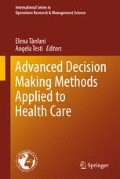Abstract
Rare diseases affect a great number of patients that suffer of the non existence of effective cures. Medical products for prevention, diagnosis or treatment of this kind of disorders are called orphan drugs and pharmaceutical industries have not a great interest under normal market conditions in developing and marketing products for a small number of patients. The Orphan Drug Act and the Regulation on Orphan Medicinal Products played a relevant role in encouraging the development of new orphan drugs, as in America as in Europe. In this chapter we propose that pharmaceutical industries coordinate their researches in order to avoid that two or more of them study a new molecule for the same disease, with the aim of further enhancing the research on rare diseases.
Access this chapter
Tax calculation will be finalised at checkout
Purchases are for personal use only
References
Centro Nazionale Malattie Rare (National Center for Rare Diseases). http://www.iss.it/cnmr/. Accessed 28 May 2011
DiMasi, J.A., Hansen, R.W., Grabowski, H.G.: The Price of Innovation: New Estimates of Drug Development Costs. J. of Health Econ. 22, 151–185 (2003)
European Medicines Agency. http://www.ema.europa.eu/. Accessed 26 May 2011
European Parliament and Council: Regulation (EC) NO 141/2000 of the European Parliament and of the Council of 16 December 1999 on Orphan Medicinal Products. Off. J. of the Eur. Communities 43, 1–5 (2000)
Eurordis — Rare Diseases Europe. http://www.eurordis.org/. Accessed 30 May 2011
Gale, D., Shapley, L.S.: College Admissions and the Stability of Marriage. The Am. Math. Mon. 69, 9–15 (1962)
Gites, B., Chughtai, M., Chang, J., Philips, I.M.: Benefits of the Orphan Drug Act for Rare Disease Treatments. TuftScope. http://s3.amazonaws.com/tuftscope exclusives/documents/10/Express Online Spring 2010 Gites.pdf (2010). Accessed 25 May 2011
Grabowski, H.: Increasing R&D Incentives for Neglected Diseases — Lessons from the Orphan Drug Act. In: International Public Goods, and Transfer of Technology under a globalized Intellectual Property Regime, pp. 457–480. Cambridge University Press, Cambridge (2005)
Heemstra, H.E., de Vrueh, R.L.A., van Weely, S., Büller, H.A., Leufkens, H.G.M.: Orphan drug development across Europe: bottlenecks and opportunities. Drug Discov. Today 13, 670–676 (2008)
Love, J.: Evidence Regarding Research and Development Investments in Innovative and Non-Innovative Medicines. Consumer Project on Technology, Washington, DC. http://www.cptech.org/ip/health/rnd/evidenceregardingrnd.pdf (2003). Accessed 24 May 2011
Martello, S., Toth, P.: Knapsack Problems: Algorithms and Computer Implementations. John Wiley and Sons, New York (1990)
Orphan Europe. http://www.orphan-europe.com/. Accessed 27 May 2011
Papadimitriou, C.H., Steiglitz, K.: Combinatorial Optimization: Algorithms and Complexity. Prentice-Hall, New Jersey (1982)
Roth, A.E., Sotomayor, M.: The College Admissions Problem Revisited. Econometrica 57, 559–570 (1989)
Senate andHouse of Representatives of theUnited States ofAmerica: OrphanDrugAct. Public Law 97–414, 97th Congress (1983)
Senate and House of Representatives of the United States of America: Rare Diseases Act of 2002. Public Law 107–280, 107th Congress (2002)
Author information
Authors and Affiliations
Corresponding author
Editor information
Editors and Affiliations
Rights and permissions
Copyright information
© 2012 Springer-Verlag Italia
About this chapter
Cite this chapter
Chessa, M., Fragnelli, V., Gagliardo, S. (2012). A coordination model for enhancing research on rare diseases. In: Tànfani, E., Testi, A. (eds) Advanced Decision Making Methods Applied to Health Care. International Series in Operations Research & Management Science, vol 173. Springer, Milano. https://doi.org/10.1007/978-88-470-2321-5_4
Download citation
DOI: https://doi.org/10.1007/978-88-470-2321-5_4
Publisher Name: Springer, Milano
Print ISBN: 978-88-470-2320-8
Online ISBN: 978-88-470-2321-5
eBook Packages: Business and EconomicsEconomics and Finance (R0)

